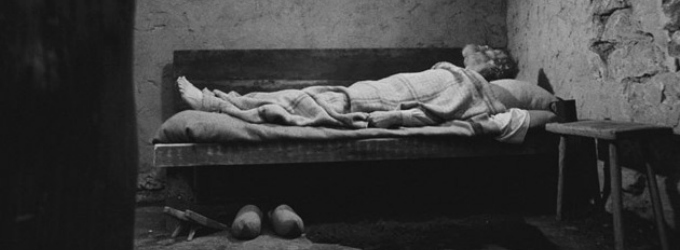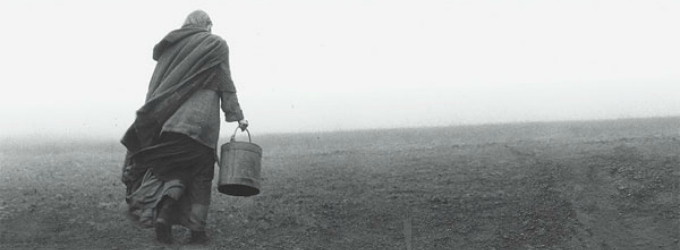httpvh://youtu.be/ZNkN_xCXozw
Hungarian director Bela Tarr’s latest film, THE TURIN HORSE, which won last year’s Silver Bear at the Berlin film festival and attracted a great deal of critical acclaim, has finally been released in the UK.
The arrival of a new release by this most idiosyncratic of filmmakers is always a noteworthy event in the cinematic calendar, but the release of THE TURIN HORSE has special significance, since Tarr has announced it as being his final film. Some might see this as an unusual move for a director at the height of his powers, but in Tarr’s case it is entirely in keeping with this most uncompromising of filmmakers: he feels he has said everything he wants to say, so it’s time to stop.
… an entirely fitting conclusion to a brilliant cinematic career.
THE TURIN HORSE’s sense of finality – with a closing shot that seems to distil all Tarr’s art into a single image, both vividly simple and quietly devastating – seems an entirely fitting conclusion to a brilliant cinematic career. The director’s unique, elegantly slow style, which achieves a remarkable purity of vision in this film, leads some to label Tarr’s cinema as ‘difficult’, but for others he is one of the world’s great directors.
THE TURIN HORSE begins with a brief prologue, a voiceover relating the story of Nietzsche in Turin intervening to prevent the mistreatment of a horse by a cabman. After this incident we know that Nietzsche lived out his life “gentle and demented, in the care of his mother and sisters”. The narration ends: “Of the horse we know nothing”. The story that follows is simplicity itself: a minimal narrative about a father (who may or may not be Nietzsche’s cabman) and daughter living a primitive, repetitive existence in a remote rural dwelling situated in a harsh, forlorn landscape, the howling wind a constant unsettling presence. And the horse, of course, who seems – like the world around – to be undergoing a slow, sad demise.
Tarr has always shown an iron determination to make exactly the kind of films he wants. The way he chooses to tell this story is typical of his most celebrated films, and illustrates why his work has been described as the antithesis of the Hollywood model. The most obvious, and most often commented on, stylistic trait is the use of long, slow, gracefully choreographed, often understated, and beautifully photographed black and white shots. THE TURIN HORSE, for instance, has only 30 shots in its 146 minutes running time.
Tarr often says that his films are not allegorical, they are just about real people and real life.
This approach allows Tarr to emphasise two other important textures in his films: the use of time and space. The camera is rarely still, gliding slowly through each scene, observing every minute detail. It is an immersive experience, where the sense of time passing and the physicality of the space convey both a striking impression of realism and a simultaneous awareness of the poetic. The stress on real time, unbroken observation seems designed to prioritise understanding of the everyday experience of existence over the necessities of narrative development. Tarr often says that his films are not allegorical, they are just about real people and real life.
With this underlying interest in realism, it is perhaps no surprise to discover that Tarr’s first amateur films were influenced by documentaries. His first feature, FAMILY NEST, was made in 1977 when he was 22, and was very much in the manner of the Hungarian ‘documentary fiction’ films (hand-held cameras, a tendency for improvisation, non-professional actors, etc). He went on to make two further features, to some extent in a similar vein – THE OUTSIDER (1981), THE PREFAB PEOPLE (1982) – while AUTUMN ALMANAC (1985) began to shows signs of a more stylised approach. Macbeth – a made for television video he filmed in 1982 – showed the direction he would later take: it comprised only two shots, a short introduction followed by a single shot of 67 minutes.
However, it was with DAMNATION (1988) that the now familiar Tarr style was fully revealed. This film also marked the first time that Tarr worked with novelist and scriptwriter Laszlo Krasznahorkai (DAMNATION was based on one of Krasznahorkai‘s short stories), who he would continue to collaborate with on all his future films. From the long, unhurried opening shot it is immediately apparent that this story of love and intrigue is going to unfold in an unconventional manner. While the narrative crawls forwards, the camera is preoccupied with the rain soaked, muddy streets, and their stray dogs; the rough and ready Titanik bar; and above all the faces – often impassive and ambivalent.
Tarr’s next feature was the epic SATANTANGO (1994), famously running at over seven hours, with only about 150 shots, many of them lasting 10 minutes or so. Before its release on DVD this film was only rarely seen and had obtained a kind of mythical status. Susan Sontag said of the film: “Devastating, enthralling…I’d be glad to see it every year for the rest of my life.” It tells the story of a farm collective and the return of the charismatic Irimias (with his comic sidekick) who offers the inhabitants the prospect of a new life, providing they entrust their savings to him. The story, based on a novel by Krasznahorkai, is structured like a tango, with the narrative moving forwards and backwards, taking in the same events from the perspectives of different characters. It is an audacious and magnificent cinematic work, with scenes that stay forever etched in the memory.
Within a few moments, the scene has transformed from gently comic oddness to an exquisite and moving sense of suspended time …
SATANTANGO is often cited as Tarr’s masterpiece, but a film which is arguably more deserving of that label is the director’s next release WERCKMEISTER HARMONIES (2000). Coming in at a comparatively short 145 minutes, and again based on a Laszlo Krasznahorkai novel, it is set in a rural town where the sense of order is threatened by the arrival of strangers. The film has one of cinema’s great opening scenes – a single, brilliant 10 minute shot, which on its own provides ample proof of Tarr‘s skill. In a bar at drinking-up time the drunken locals ask the film’s main protagonist – Janos – to perform what is clearly a familiar ritual. With the locals co-opted to act as the sun, earth and moon, Janos demonstrates how an eclipse takes place, moving the people representing the ‘moon’ and the ‘earth’ in a comic, inebriated shuffle around the ‘sun’. At the moment of ‘eclipse’, a charged stillness falls over the scene; the camera slowly pulls back and rises to a high position, while a beautifully sparse, contemplative melody emerges on the soundtrack. Within a few moments, the scene has transformed from gently comic oddness to an exquisite and moving sense of suspended time – as if the film is holding its breath. It is one of those magical cinematic moments; a scene which can only be described as perfect in conception and realisation.
httpvh://youtu.be/8YGdkxI0rU4
WERCKMEISTER HARMONIES was followed by THE MAN FROM LONDON (2007), based on a George Simenon novel, which becomes a kind of existential noir in Tarr’s hands. Although it does not have the ambition and scale of the previous two films, it still has many memorable sequences. Like many of Tarr’s films, the opening scene is magnificent, and proof that Tarr can handle narrative exposition with great skill. The next release, THE TURIN HORSE (2011), brings us back to the present, and the final film by the Hungarian auteur. The film’s grim, understated, powerful, apocalyptic vision, certainly feels like an appropriate end piece to the work of this particular cinematic giant.
Tarr leaves behind a truly great body of work; some of the most astonishing, ambitious, intriguing, bold, melancholy, thoughtful, and beautiful cinematic works that have graced this comparatively young art-form. Tarr’s work represents a unique cinematic vision, and one which will be sorely missed.
Witness the power of the Tarr on the big screen: THE TURIN HORSE is screening now at the Curzon Renoir in London, and will be showing at Cambridge Arts Picturehouse on the 22nd June.




2 thoughts on “Focus On: Bela Tarr”
Comments are closed.